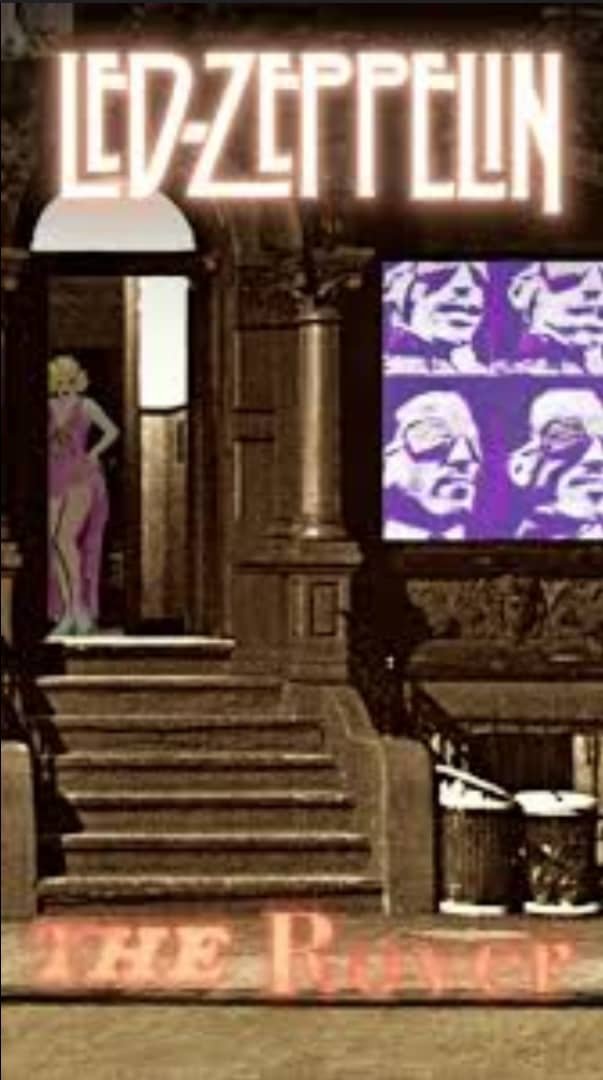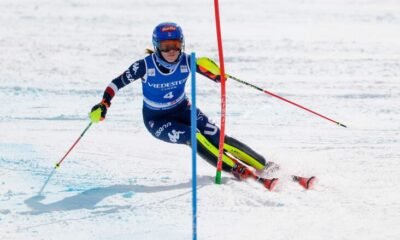Blog
Still Carved in Stone: Celebrating 50 Years of Led Zeppelin’s Physical Graffiti
Fifty years ago, Led Zeppelin released a double album that didn’t just expand their sound—it expanded the possibilities of what a rock album could be. Physical Graffiti, unleashed on February 24, 1975, was sprawling, unpredictable, and unapologetically eclectic. It wasn’t a safe record, nor was it meant to be. Across its fifteen tracks, the band wandered through heavy blues, acoustic folk, funk, prog, and Eastern-inspired rock, stitching it all together with the unshakable chemistry that defined them. Half a century later, it’s still as vital, strange, and exhilarating as it was when the needle first hit the groove.
Today, fans around the world are marking the milestone, and Led Zeppelin has given them the perfect soundtrack for it: freshly spotlighted streams of “Custard Pie” and “The Rover” on their official YouTube channel. For those who grew up with Physical Graffiti, hearing these opening tracks again is like stepping back into a room you haven’t visited in decades—everything feels familiar, yet charged with new details you somehow missed before. For newer listeners, it’s a reminder that Zeppelin wasn’t just about “Stairway to Heaven” or “Whole Lotta Love.” This was a band capable of opening a double album with two very different punches, both equally irresistible.
“Custard Pie” kicks things off with swagger, pure and unfiltered. Jimmy Page’s guitar is thick and greasy, sliding into a blues groove that’s part traditional riff, part unhinged funk. John Paul Jones locks in with John Bonham to create a rhythm section that’s both stomping and sly, while Robert Plant delivers lyrics dripping with innuendo. There’s a looseness to the track—a sense that it’s being conjured in real time, with Page’s guitar fills darting in and out like quick jabs. Listening now, it’s easy to hear how this opener sets the tone for the rest of the album: confident, unpredictable, and just a little dangerous.
Then comes “The Rover,” a song born from the band’s restless spirit. It opens with a chiming guitar figure that feels almost pastoral before Bonham crashes in with his unmistakable power, turning the track into a rolling, road-ready anthem. Plant’s lyrics reflect movement and escape—“I’ve been to London, seen seven wonders”—and his delivery carries both excitement and a tinge of weariness. Page’s riffs are meaty but melodic, while Jones’s bass work snakes underneath with effortless grace. It’s the kind of song that sounds best with the windows down, the horizon wide open, and the road stretching endlessly ahead.
Hearing these two tracks back-to-back again, even outside the context of the full album, is a reminder of Zeppelin’s range. “Custard Pie” is playful and raw; “The Rover” is expansive and anthemic. They set the stage for what was, and remains, one of the most diverse albums in rock history.
Physical Graffiti itself was a product of both intention and circumstance. The band had been recording new material at Headley Grange, the remote English estate that had already served as the birthplace of “Stairway to Heaven” and much of Led Zeppelin IV. When they realized they had more songs than would fit on a standard LP, they reached back into the vault, pulling out unused tracks from previous sessions. The result was a double album that felt like a greatest-hits compilation of unreleased material—except these weren’t leftovers. They were songs strong enough to stand alongside the new material, creating a tapestry that spanned the breadth of Zeppelin’s sound.
The tracklist is a journey in itself. From the ferocious “In My Time of Dying” to the tender “Bron-Yr-Aur,” from the funk-laden “Trampled Under Foot” to the monumental “Kashmir,” it’s an album that invites you to live in its world for a while. The sequencing feels almost cinematic, shifting moods without warning yet somehow maintaining cohesion. It’s easy to forget that Physical Graffiti is over eighty minutes long because it never drags; every track has its own pulse, its own reason for being there.
Part of the album’s enduring power lies in its production. Page, as producer, had an instinct for space—not just in the arrangements, but in the way the instruments breathe. Bonham’s drums, famously huge, sound as if they’re being played in the same room you’re in. Jones’s keys and bass are given room to move, adding subtle complexity to even the heaviest tracks. Plant’s vocals, alternately feral and tender, are never buried. And Page’s guitar work ranges from delicate acoustic picking to monolithic riffs, often within the same song.
Fifty years on, Physical Graffiti also stands as a testament to the band’s willingness to take risks. In an era when many rock bands were doubling down on formulas that worked, Zeppelin made an album that sprawled across genres without apology. It was a statement: they weren’t just a hard rock band, they were a band that could do anything—and do it convincingly.
The cultural impact was immediate. Upon release, Physical Graffiti shot to number one on both the UK and US charts. Critics, often divided on Zeppelin, largely praised the album’s scope and ambition. Fans devoured it, dissecting its lyrics, marveling at its musicianship, and wearing out their vinyl copies. The brownstone building featured on the cover, a New York City tenement with the words “Physical Graffiti” spelled out in its windows, became a pilgrimage site for fans—proof that even the album’s artwork carried its own mythology.
Today, the 50th anniversary feels like both a celebration and a reaffirmation. In a music world dominated by playlists and singles, Physical Graffiti remains an argument for the immersive power of the album format. It’s a record that demands—and rewards—start-to-finish listening. Yet Zeppelin’s decision to release “Custard Pie” and “The Rover” for streaming on YouTube is a savvy nod to the present. It gives longtime fans a quick hit of nostalgia and invites new listeners to dive deeper.
And perhaps that’s the most fitting tribute to Physical Graffiti: the fact that it still has the ability to pull people in, to make them stop what they’re doing and just listen. Whether it’s blasting from a turntable in 1975 or streaming through earbuds in 2025, the album still carries that same mix of raw power and musical curiosity.
If you haven’t listened in a while, start with those two opening tracks. Let “Custard Pie” swagger its way into your ears, then let “The Rover” take you down a winding road you didn’t know you needed to travel. And then, don’t stop. Keep going through the rest of Physical Graffiti. Half a century later, it’s still an album that doesn’t just stand the test of time—it makes time feel irrelevant.
For Led Zeppelin, Physical Graffiti wasn’t just another release. It was proof that they could push themselves beyond the limits of what rock music was expected to be. For fans, it was a treasure chest that kept yielding new discoveries with every listen. And fifty years on, that treasure hasn’t lost its shine.
You can hear “Custard Pie” and “The Rover” now on Led Zeppelin’s official YouTube channel. But be warned: once you start, you may find yourself climbing through all fifteen tracks, wondering how something this old can still feel so alive. That’s the magic of Physical Graffiti. It’s not just an album. It’s a world—and after fifty years, the door is still wide open.
-

 Blog5 months ago
Blog5 months agoPat Kelsey sends a strong three-word fiery message to the Louisville basketball’s team after their Cardinals 14th win…
-

 Blog7 months ago
Blog7 months agoNetflix releases “The Underdog,” a much-anticipated documentary about Drew Brees. slated for publication on the 25th
-

 Blog5 months ago
Blog5 months agoMikaela Shiffrin responds to cross-country skier Jessie Diggins’ letter following her failure to secure a solitary podium finish at the FIS Nordic Worlds
-

 Blog3 months ago
Blog3 months agoBehind the Turns: Netflix’s Upcoming Documentary on Mikaela Shiffrin’s Fights, Fears, and Love
-

 Blog4 months ago
Blog4 months agoLegacy Tour Led Zeppelin has officially confirmed their 2026 reunion tour, which will be their first extensive live performances since 2007. The “Led Zeppelin Legacy Tour 2026” will begin on June 10, 2026, at Los Angeles’ SoFi Stadium.
-

 Blog5 months ago
Blog5 months agoWomen’s Slalom Run 1 at the FIS Alpine Skiing World Cup: Are
-

 Blog5 months ago
Blog5 months ago“Courtside to Aisle-Side: Tyrese Haliburton and Jade Jones Set New Wedding Date”
-

 Blog7 months ago
Blog7 months agoFederica Brignone: “I’m fine, but my return to skiing is far off.”
